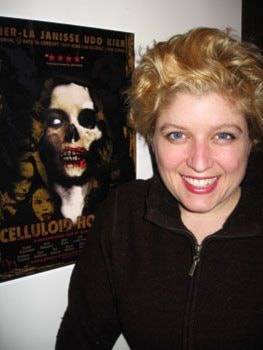In the Shadow of the Midnight Sun has destroyed Catherine Deer’s preconceptions of Inuit and Sami art.
Traditional soapstone carvings and drawings were nowhere to be seen.
Instead, the Yukon Arts Centre gallery is full of an eclectic mix of modern paintings, folded-paper photos, embroidered hangings and quirky, funny carvings.
It’s a coup to have this show in Whitehorse, said assistant curator Maya Hirschman during Thursday’s opening.
“We got it before the National Gallery did,” she said.
The show, comprised of Sami and Inuit art created between 2000 and 2005, was originally commissioned as a cultural component to accompany the 2002 Norwegian royal visit.
It didn’t pan out, so the Art Gallery of Hamilton picked up the show and expanded it to include pan-northern works.
It might be one of the last big shows the Yukon gallery gets, now that Prime Minister Stephen Harper’s government cut national Exhibition Transportation Service funding, said Hirschman.
“It speaks of the North without falling back on Yukonia,” said local photographer Mario Villeneuve, enjoying the exhibit.
“There are no northern lights or ravens.
“It’s an exciting show for Yukoners — to see there’s something else out there.”
Northern art has moved beyond landscape and animals, said Deer, who’s charcoal drawings fill one of the rooms.
“It has pushed the metaphor further as people speak in different voices and expand,” said the Yukon artist.
Deer’s show, Drawn to Memory, deals with her childhood memories of Baker Lake.
Although she was only three years old when her father was posted there with the RCMP, Deer was “really affected by the North.
“The landscape and lifestyle flavoured how I feel about winter and the dark,” she said.
Shades of grey and white give Deer’s charcoal works a wintry, northern feel.
“I’ve always worked in the arts, but I’m just re-emerging as an artist now,” she said.
“And this show has been with me for years — it’s an exorcism.”
Several of Deer’s large drawings cut off the heads of her subjects.
It’s a child’s perspective, and hands, not faces, are the focus of her work.
Simple blue waves stretch across one drawing of sled dogs resting on ice.
The caption relates the afternoon Deer, as a toddler, wandered into the midst of a yard of barking, unsocialized huskies:
“The dogs were tethered outside, but always away from the homes as they were not pets, but working animals … I accidentally wandered into their midst. Calmly and quietly their handler came through the tied dogs to me, picked me up and carried me out.
“It could have turned out very differently.”
A large red orb in another of Deer’s drawings stands out in the mostly grey room.
The Red Ball symbolizes the beacons laid in the snow for the supply planes.
From her window, Deer could see this mysterious red light.
“I was obsessed with the red ball,” she said.
As a child she wanted to touch it. And when she was finally pulled there on a toboggan, she was amazed by its size.
“The red ball was only an airplane marker, positioned strategically on the frozen water to guide the planes down.
“But to me, it was the first experience of what far away meant.”
Deer relied on her father’s amateur photographs for some of the work, but mostly they just added to her memories.
“They were fleshed out with family stories and his photographs,” she said.
But Deer’s show is about more than memories.
It chronicles a disappearing lifestyle.
“It’s important to talk about this through art, because it’s a way of life that is almost gone,” she said, citing the Inuit tradition of drying clothes on tufts of tundra grass.
“And I was privileged to experience part of it.”
Winter is still Deer’s favourite time of year.
“I feel cozy, comfortable and safe in darkness,” she said.
“And I think it comes from the emotions I felt there.”
Deer’s show fits so well with the northern Midnight Sun exhibition, acting curator Mary Bradshaw joked about slipping some of Deer’s work out with the touring exhibit.
Outside the gallery, in the alcove known as the Grotto, is a very different show.
A group of women from Ynklude have created self-portraits, masks and collages.
Gallery intern Heather Read helped put the exhibit together.
Before moving north, Read did a similar project with people with disabilities in St. John’s, Newfoundland.
“I was curious what life was like up here for people with disabilities,” she said.
“And I wanted to bring their work to a public space — it’s important for them to feel included and welcomed and feel they have a voice.”
The art is often simple and striking.
Cut and pasted onto one piece are the words “death and surviving.”
“I thought it sounded neat,” said artist Megan Gates.
“I really liked the colours and thought they looked good together.
Gates showed off her tattoos — the colours matched.
Another work has photos of the artist as a young girl.
“I was spoiled,” said artist Michael V. Ador.
Then she pointed out another part of the collage — a picture of a face with the eyes covered up.
“Bad things happened to me too,” she said.
“And this shows I don’t want to look at it.”
Self-portraits are an easy thing for artists to dive into, said Read, who wasn’t surprised by the quality of the physical work.
It was the vitality of the group of women, part of the Yukon Association of Community Living, that astonished her, she said.
“I think it’s important for the art world to see there are lots of different ways of making art and expressing yourself.”
Ynklude’s show runs until February 10th.
In the Shadow of the Midnight Sun is at the Yukon Arts Centre gallery until March 9th.
